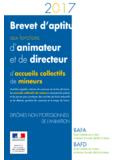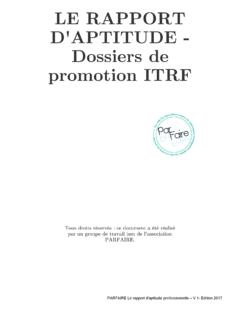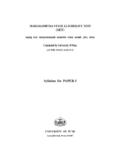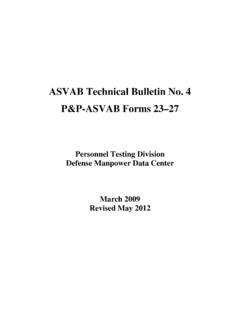Transcription of The ABC of Gender Equality in Education - OECD
1 Programme for International Student AssessmentThe ABC of Gender Equality in EducationApTiTudE, BEhAviour, ConfidEnCEThe ABC of Gender Equality in EducationAptitude, BehAviour, ConfidenCeThis work is published under the responsibility of the Secretary-General of the OECD. The opinions expressed and the arguments employed herein do not necessarily reflect the official views of the OECD member document and any map included herein are without prejudice to the status of or sovereignty over any territory, to the delimitation of international frontiers and boundaries and to the name of any territory, city or cite this publication as: OECD (2015), The ABC of Gender Equality in Education .
2 aptitude , Behaviour, Confidence, PISA, OECD 978-92-64-23002-6 (print)ISBN 978-92-64-22994-5 (PDF)The statistical data for Israel are supplied by and under the responsibility of the relevant Israeli authorities. The use of such data by the OECD is without prejudice to the status of the Golan Heights, East Jerusalem and Israeli settlements in the West Bank under the terms of international credits: Flying Colours Ltd /Getty Images Jacobs Stock Photography /Kzenon khoa vu /Flickr /Getty Images Mel Curtis /Corbis Shutterstock /Kzenon Simon Jarratt /CorbisCorrigenda to OECD publications may be found on line at.
3 OECD 2015 You can copy, download or print OECD content for your own use, and you can include excerpts from OECD publications, databases and multimedia products in your own documents, presentations, blogs, websites and teaching materials, provided that suitable acknowledgement of OECD as source and copyright owner is given. All requests for public or commercial use and translation rights should be submitted to Requests for permission to photocopy portions of this material for public or commercial use shall be addressed directly to the Copyright Clearance Center (CCC) at or the Centre fran ais d exploitation du droit de copie (CFC) at ABC of Gender Equality in Education : aptitude , BehAviour, ConfidenCe OECD 20153To compete successfully in today s global economy, countries need to develop the potential of all of their citizens.
4 They need to ensure that men and women develop the right skills and find opportunities to use them productively. Many countries are working towards achieving Gender parity at the workplace and in access to jobs. In Education , too, many countries have been successful in closing Gender gaps in learning outcomes. Yet, as this report reveals, even when boys and girls are equally proficient in mathematics and science, their attitudes towards learning and aspirations for their future are markedly different and that has a significant impact on their decisions to pursue further Education and their choice of ABC of Gender Equality in Education .
5 aptitude , Behaviour, Confidence tries to determine why 15-year-old boys are more likely than girls, on average, to fail to attain a baseline level of proficiency in reading, mathematics and science, and why high-performing 15-year-old girls still underachieve in areas such as mathematics, science and problem solving when compared to high-performing boys. In 2012, 14% of boys and 9% of girls surveyed by the PISA exercise did not attain the PISA baseline level of proficiency in any of the three core subjects.
6 On the other hand, in the top-performing economies in PISA, such as Shanghai-China, Singapore, Hong Kong-China and Chinese Taipei, girls perform on a par with their male classmates in mathematics and attain higher scores in mathematics than boys in most other countries and economies around the world. As the evidence in the report makes clear, Gender disparities in performance do not stem from innate differences in aptitude , but rather from students attitudes towards learning and their behaviour in school, from how they choose to spend their leisure time, and from the confidence they have or do not have in their own abilities as students.
7 In fact, the report shows that the Gender gap in literacy proficiency narrows considerably and even disappears in some countries among young men and women in their late teens and 20s. Giving boys and girls an equal opportunity to realise their potential demands the involvement of parents, who can encourage their sons and daughters to read; teachers, who can encourage more independent problem solving among their students; and students themselves, who can spend a few more of their after-school hours unplugged .This report is a valuable contribution to the OECD s work on Gender issues, which examines existing barriers to Gender Equality in Education , employment and entrepreneurship with the aim of improving policies and promoting Gender Equality in both OECD and partner countries.
8 It shows clearly that we cannot rest complacent. We can provide a better future to our children if we act upon the evidence presented in this Gurr aOECD Secretary-GeneralForewordThe ABC of Gender Equality in Education : aptitude , BehAviour, ConfidenCe OECD 20155 This report is the product of a collaborative effort between the countries participating in PISA and the OECD Secretariat. The report was drafted by Francesca Borgonovi and Marilyn Achiron, with contributions from Giannina Rech and Angelica Salvi del Pero.
9 Andreas Schleicher, Michael Davidson, Yuri Belfali, Monika Queisser, Francesco Avvisati and Joel Rapp provided valuable feedback at various stages of the report. Fran ois Keslair, Louise Caron, Lorena Ortega Ferrand, C lia Braga-Schich, Sophie Limoges, Alfonso Echazarra, Daniel Salinas, Miki Tadakazu, Juliet Evans, Claire Chetcuti, Elisabeth Villoutreix and Louise Binn provided statistical, editorial and administrative support. The development of the report was steered by the PISA Governing Board, which is chaired by Lorna Bertrand (United Kingdom).
10 AcknowledgementsThe ABC of Gender Equality in Education : aptitude , BehAviour, ConfidenCe OECD 20157 ExEcutivE Summary ..13rEadEr S GuidE ..17 CHAPTER 1 EmErGiNG Gender GaPS iN Education ..19 Historic progress in young women s Education ..21 Low-performing girls ..27 What happens as girls and boys pursue further Education or work ..32 CHAPTER 2 tacKLiNG uNdErPErFOrmaNcE amONG BOyS ..35 How do boys and girls spend their time outside of school? Wired and connected ..37 Video gaming and student performance ..42 How do boys and girls spend their time outside of school?
















